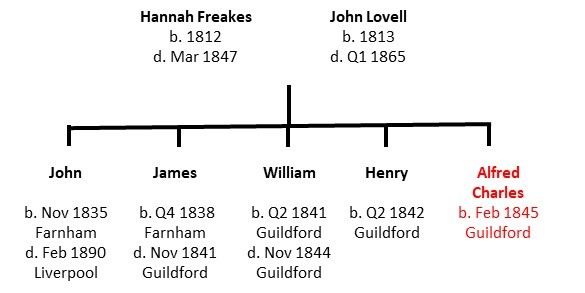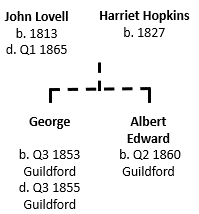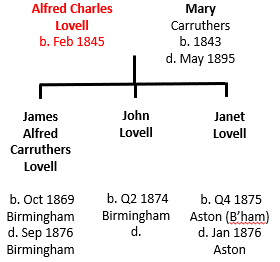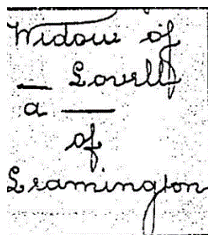Alfred lovell
Subject Name : Alfred Lovell (b 1845 – d ?)
Researchers : Pauline Sieler, Mike Brock, Carol Thompson
Following the death in quick succession of two of his children, seemingly respectable mercantile clerk Alfred Lovell became an inmate at the Guildford Union Workhouse 100 miles away from his wife and remaining child, and then simply disappeared.
Alfred Charles Lovell was born on 23rd January 1845 in Stoke-next-Guildford, Surrey, the son of John and Hannah Lovell née Freakes. Baptised a few weeks later on 2nd March at Guildford’s St John the Evangelist Church, Alfred was John and Hannah’s fifth son, although two of them, James and William, had died, both age 3, in 1841 and 1844 respectively.
The family were living at 6 Chertsey Street in the centre of Guildford where John worked as a shoemaker.  He came from a Dissenters’ or Non-Conformist religious background and was once described as a ‘man of solid sense and immovable honesty’ .
He came from a Dissenters’ or Non-Conformist religious background and was once described as a ‘man of solid sense and immovable honesty’ .
Before long, Alfred’s mother Hannah was expecting her sixth child, but she died in premature labour on 18th March 1847 age 34. This left John, also about 34, with two small boys to look after – two-year-old Alfred and Henry, 4 – while trying to maintain his job. Hannah’s parents Thomas and Sarah Freakes were living very close by in North Street so they may well have helped with caring for them.
Meanwhile, the boys’ 12-year-old brother John was already earning a wage as he had been at work since he was 10 – schooling was not yet compulsory in England. Newspaper articles published over 40 years later which looked back on the life of John said that he had only spent six months at school before he started work as a grocer. The reason for those reports, which were reproduced in newspapers all over England, was that Alfred’s brother John had gone on to become one of the most important and respected journalists of the 19th Century.
Four years after Alfred’s mother’s death, the 1851 Census showed Alfred, 6 and Henry, 8 with their 37-year-old father John, still working as a shoemaker at 6 Chertsey Street. The boys’ 16-year-old brother John was a clothier’s assistant living in Guildford High Street.
The boys gained themselves a stepmother the foll owing year when their father married 25-year-old general servant Harriet Hopkins on 24th August 1852 at Albury, near Guildford. John and Harriet had two children, George in 1853 and Albert Edward in 1860.
owing year when their father married 25-year-old general servant Harriet Hopkins on 24th August 1852 at Albury, near Guildford. John and Harriet had two children, George in 1853 and Albert Edward in 1860.
By the time of the 1861 Census, Alfred was 16, working as a grocer. Still in Chertsey Street, he was the only one of his family elders not working in his 47-year-old father shoe making business – brother Henry, 18, was now a shoemaker while stepmother Harriet, 34, was a shoe binder. One-year-old Albert completed the household as sadly Alfred’s other half-brother George had died in 1855 age 2.
Alfred’s eldest brother John had, as a teenager, taught himself shorthand in his ambition to become a journalist. He began working for the Surrey Standard and then the West Surrey Times before moving to Sheffield. By the time of the 1861 Census, he was a 25-year-old reporter for the Birmingham Post.
Both Alfred and Henry seemed to be influenced by the achievements of their elder brother. At some stage during the 1860s, possibly after their father’s death in 1865, Alfred also moved to Birmingham where he settled and on 31st October 1868, age 23, married 24-year-old Mary Carruthers, a dressmaker, although her occupation was not mentioned on the marriage certificate. Alfred was a ‘commercial traveller’. They were living in Branston Street, just a short walk from his brother John’s house at the time of the previous Census, although John had by now moved to London to work for a magazine. The following year, John helped establish and become the first manager of the Press Association which he ran for about ten years. He was then editor of the Liverpool Mercury before he died aged 54 in 1890.
Alfred and John’s brother Henry had also turned to journalism, rising through the ranks to become the editor of the Leighton Buzzard Observer by the time of his marriage to Sarah Ann Sloan in September 1870 in Dunstable, Bedfordshire.
Alfred, however, did not follow the same path as his brothers. He left behind his career as a commercial traveller to become an ‘office clerk’, his occupation noted on the birth certificate of his first child, James Alfred Carruthers Lovell, born on 12th October 1869 at the latest family home of 60 Little King Street, Birmingham.
The 1871 Census showed Alfred and Mary had moved again, living in High Street, Smethwick, just to the west of Birmingham’s centre. Alfred, 26, was a ‘merchant’s clerk’ while 25-year-old Mary was a milliner and dress maker. Strangely, their son James, who was just over a year old, was apparently not with them and has not been traced elsewhere, although it is of course possible that this was an enumerator’s error.
their son James, who was just over a year old, was apparently not with them and has not been traced elsewhere, although it is of course possible that this was an enumerator’s error.
Alfred and Mary’s second child, John, was born in 1874, followed just over a year later by a daughter Janet. Sadly Janet died age just 3 months in January 1876 from bronchitis at their home at 69 Willis Street, Aston. Eight months later, Alfred and Mary’s eldest child James also died, age 6, from scarlatina (scarlet fever) and cynache parotidea (mumps).
This clearly would have had a terrible impact on Alfred and Mary, but what caused them by the time of the 1881 Census to be living separate lives is not known. That Census showed Alfred to be an ‘inmate’ in the Guildford Union Workhouse, age 35, married, a ‘clerk mercantile’, born in Stoke, Surrey. 100 miles (160km) north-west of Guildford, his wife Mary and their 7-year-old son John were living at 27 Scotland Place, Leamington, near Warwick. Mary, 32, was noted as a married dressmaker.
Whatever the reason for Alfred being back in the town of his birth, the 1881 Census is the last confirmed record found for his life. However, there is an article in the Surrey Times from July 1883 about an Alfred  Lovell which may have been him. This Alfred, a shoemaker, was found drunk and sleeping in an unoccupied building in Guildford by a policeman. At the Guildford Bench, Alfred said that he was homeless and had gone into the building for shelter. He was released with a caution but was not heard from again.
Lovell which may have been him. This Alfred, a shoemaker, was found drunk and sleeping in an unoccupied building in Guildford by a policeman. At the Guildford Bench, Alfred said that he was homeless and had gone into the building for shelter. He was released with a caution but was not heard from again.
Alfred’s wife Mary, from at least 1886, was living and working as before in Leamington as a dressmaker, now at 19 Chandos Street. From 1889 to 1895, Electoral Rolls show Mary Lovell at 19 Chandos Street with no mention of Alfred. The 1891 Census confirmed her there with her 17-year-old son John, a fishmonger, and four lodgers. Mary’s status was a widow, but with no death record found for Alfred, this may not necessarily have been true.
Direc tories continued to show Mary as a dressmaker at 19 Chandos Street until 1895, when illness forced her into the nearby Warwick Union Workhouse. She passed away there on 23rd May from nephritis and dropsy age given as 45, although her actual age was 51. Mary’s death certificate showed that she had revealed nothing about Alfred during her time in the Workhouse. The Warwick Union master, witness to her death, noted that Mary was the ‘widow of ___ Lovell, a ___ of Leamington’.
tories continued to show Mary as a dressmaker at 19 Chandos Street until 1895, when illness forced her into the nearby Warwick Union Workhouse. She passed away there on 23rd May from nephritis and dropsy age given as 45, although her actual age was 51. Mary’s death certificate showed that she had revealed nothing about Alfred during her time in the Workhouse. The Warwick Union master, witness to her death, noted that Mary was the ‘widow of ___ Lovell, a ___ of Leamington’.
Could this be a glimpse of what her feelings were towards Alfred and what happened back in Leamington? The truth will probably never be known.
December 2019, updated February 2024
Sources
FamilySearch.org
FindMyPast.co.uk / British Newspaper Archive
FreeBMD.org.uk
General Register Office GRO.gov.uk
MidlandsHistoricalData.org
For a full list of references click here.
